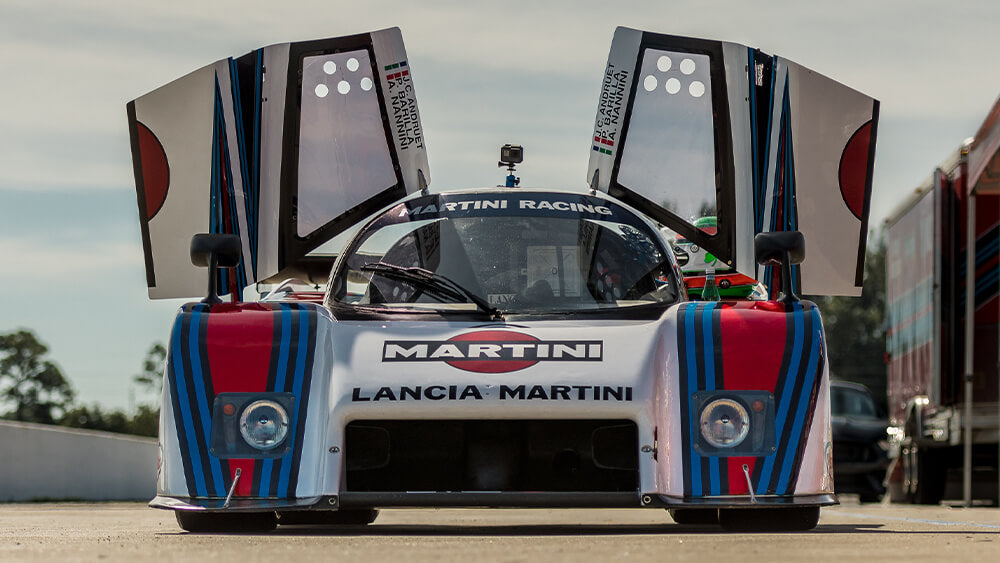Written and captured by Richard Kelley
As a young racing fan in 1970s Ireland, John Campion fell in love with Lancia rally cars that periodically tore through the woods. He would tell of memories of him and his father watching Fulvias and Stratoses flat out, slamming sideways through the crisp air, engines at redline. Three decades later, John’s dreams were answered when his luck, determination and brilliance allowed him to collect the very race cars he had worshipped in the woods and on track.
John Campion was a brilliant inventor and philanthropist, known among collectors for his "greatest hits" lineage of Lancias, including race-winners and champions: a Fulvia HF, a Stratos, an 037, a Delta Integrale, and a Delta S4, with a Fiat Abarth 131 (a model with three manufacturers championships in World Rally competition to its name) thrown in for good measure.
 © Richard Kelley
© Richard Kelley
Then, his Group C Lancia LC2 was arguably Martini Lancia's most difficult challenge. While fast, agile and beautiful in the sponsor's colors, the Lancia LC2 had to battle nose-to-nose with Porsche's iconic 956. Despite the team's best attempts, the Lancia LC2 faced too many Porsche and too little funding for ultimate success.
John’s LC2 was chassis #001 of 7, raced at Monza and Le Mans in the 1983 and ‘84 seasons, and three races at Fuji in 1985.
 © Richard Kelley
© Richard Kelley
The LC2 was built around a twin-turbocharged Ferrari V-8, an engine variant that powered the Ferrari 288 GTO and 308 QV street cars. Abarth and Dallara tuned the engine and chassis as a single unit, and by 1983, the LC2 arrived ready for hand-to-hand combat with Porsche.
From the green flag, the LC2 surprised with blistering speed. It was even more potent a year later, taking the 1984 pole at Le Mans by running 11 seconds faster than the next-quickest Porsche.
 © Richard Kelley
© Richard Kelley
The LC2’s nemesis was tires. Lancia originally developed the LC2 around Pirelli radials, which had an annoying tendency to explode. Despite the challenge, in its debut race, it took the pole at the 1983 1000 KM of Monza.
Unfortunately, partner Pirelli worked flat out to produce racing tires for Formula 1 and World Rally. The LC2 was forced to experiment with Dunlops and Michelins in the following years, with disappointing competitiveness.
Lancia never gave up, looking for more performance from the car’s engine, suspension, and electronics. At the 1984 season launch, the LC2 now carried a larger Ferrari engine, delivering more than 850 horsepower that pushed the LC2 to nearly 240 MPH down the Le Mans’ Mulsanne Straight. Despite the raw power of the LC2, the car battled every system, from the turbos to the transmission.
 © Richard Kelley
© Richard Kelley
When Campion acquired the car, he knew only of this racing history. While snooping through the car, he and his team discovered an FIA tech inspection sticker from the 1984 Kyalami (South Africa) 1000 KM race. Sure enough, chassis #001 had competed there in November 1984, when a pair of LC2s finished 1-2 (chassis #001, driven by Bob Wollek and Paolo Barilla, placed second).
Campion’s LC2 hadn’t run in 20 years, so John immediately launched a complete restoration. The gorgeous results are presented here, in all its glory and charismatic flare. Campion and his wife, Suzanne, had planned on competing as a racing team, with Suzanne in the Beta Montecarlo Turbo and John in the LC2. It wasn’t to be - John lost his battle with leukemia in 2020, and the world lost an incredibly brilliant gentleman and warm soul who made friends with everyone he ever met.
To be sure, at this moment he’s found a fair bit of woods to carve forever.
 © Richard Kelley
© Richard Kelley














































